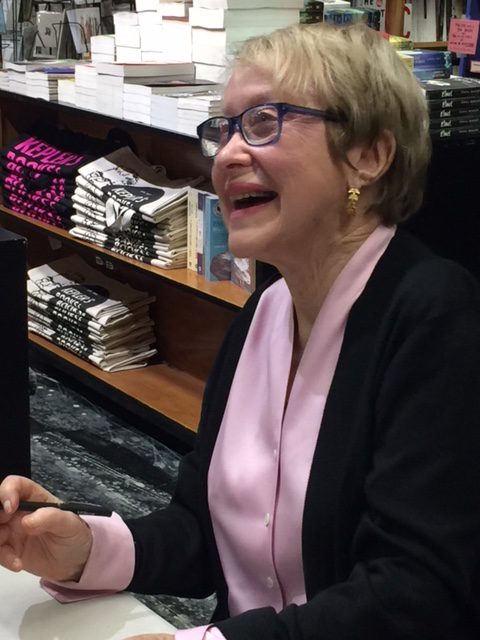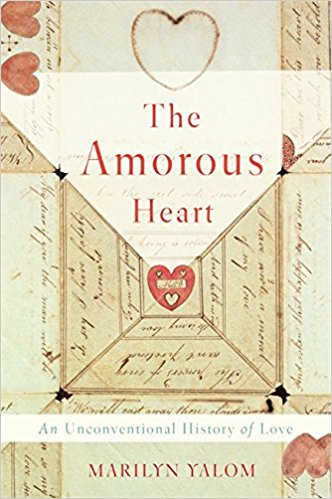Kepler’s Books ❤ Marilyn Yalom and her “Amorous Heart”
Friday, January 12th, 2018
Author in the pink. (Photo: Margo Davis)
The shape is ubiquitous: two rounded curves swooping downward to meet in a single point. It’s meaning is universal: love. But where did it come from?
Marilyn Yalom, author of the brand new The Amorous Heart: An Unconventional History of Love (Basic Books), was in the British Museum when the question came to her a few years ago, as she gazed at a treasures from the 15th century in the “Fishpool Hoard,” discovered in Nottinghamshire in the 1960s. In the midst of the jewelry: a perfect heart-shaped brooch. As she marveled at the delicately enameled piece, she knew she was hooked.
Hence her new book, which had her at Kepler’s earlier this week, in a “public conversation” with Theresa Donovan Brown, a longtime friend and sometimes co-author. Marilyn, a longtime friend of mine as well, is also the author of the acclaimed How the French Invented Love – we wrote about it here and here. (And about her husband, the eminent psychoanalyst Irving Yalom, is also an author, here and here).
The Amorous Heart is likely to be as successful as her previous efforts, with Robert Pogue Harrison proclaiming it “Another tour de force by one of America’s leading cultural historians.”
“For anyone whose heart has ever palpitated in love or devotion, this is a thumping romp through the history of hearts – in love, literature, illuminated manuscripts, and valentine cards,” added Christopher de Hamel, author of Meetings with Remarkable Manuscripts.

The heart that launched…
For the Kepler’s occasion, fueled by plenty of Prosecco and heart-shaped cookies, almost everyone seemed to be wearing pink – even yours truly, though it was happenstance in my case. Fortunately, our mutual friend, photographer Margo Davis (who was wearing NYC black, without a touch of pink) was around to document the occasion. (See photo above.)
What did she discover in her long journey that began in the British Museum? Marilyn learned that the heart has been considered the “home of love” at least as far back as Sappho, though the visual rendering didn’t occur until much later. The first known rendering is ambiguous – a heart stamped on a coin in Libya, circa the third or fourth century B.C. It may, however, reflect the shape of a variety of a fennel pod still extant during the time. (Catullus makes mention of the fennel plant as a means of contraception … a clue?)

It was “a form in search of a meaning” until the 13th century, when the troubadours were full of amour and the need to represent it. In art, however, the heart was usually portrayed as a cone-shaped object, thanks to the imprecise discoveries of medicine. Sometime in the 15th century – we don’t know how, or where, or exactly when – the heart shape caught on. By the 14th century the heart had become a commonplace symbol, as Marilyn’s beloved brooch demonstrates. By the 16th and 17th? Shakespeare uses the term “heart” almost as much as he does love.
Religion was never the same again. The “Sacre Coeur” of the Church became ubiquitous and portrayed with leaping flames and crowns of thorns. Its more regular representations continued unabated in the profane arts, too. Just as the image was about to sink into inevitable kitsch, it was revived by none other than Martin Luther.
Then, the 20th century, with more innovations. The heart became a verb, as in I ❤ NY. Or I ❤ San Francisco. Or Paris. Or Berlin. Then the computer age, and the Japanese made it into an emoji. Is it dissipating into meaninglessness? Marilyn celebrates it nonetheless. Might we suggest the delightful volume for Valentine’s Day?
“It’s the most popular symbol in the world, the perfect shape,” said Yalom. Two equal halves, conveying the Platonic idea. “It really moves our hearts, makes us feel good. Something in the shape itself.”

